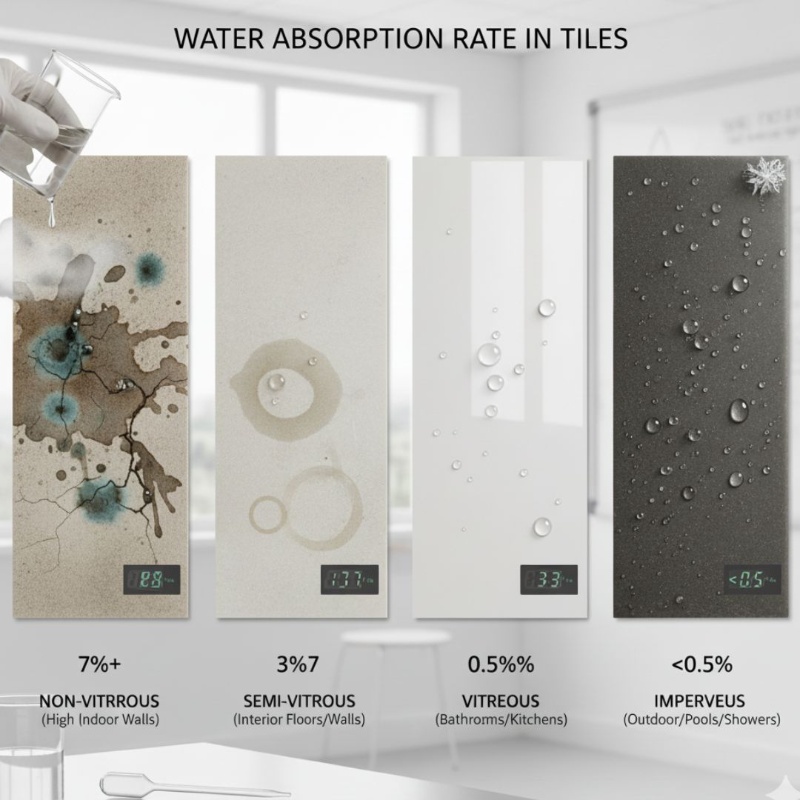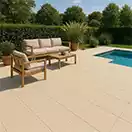What Is the Water Absorption Rate in Tiles? Why Does It Matter in the UAE?
You’ve just installed beautiful floor tiles in your villa courtyard, but after the first rain or pool splash, you notice faint patches that never dry. Over time, those marks deepen into cracks, and you wonder, What went wrong?
In the UAE’s climate, where heat, humidity, and sand constantly test building materials, the wrong tiles can age faster than expected. Moisture that seeps into tile pores weakens the tile’s structure and shortens its life.
That’s where understanding the water absorption rate in tiles becomes essential. Whether you’re an architect designing a luxury hotel or a homeowner redoing your terrace, knowing this one factor can save you from costly maintenance down the line.
Let’s explore how water absorption works, why it’s critical in the UAE, and how to choose tiles that can handle both heat and humidity with ease.
What Is the Water Absorption Rate in Tiles?
Simply put, the water absorption rate measures how much moisture a tile can absorb when exposed to water. It’s expressed as a percentage of the tile’s total weight.
For example, if a tile absorbs 0.1% of its weight in water, it’s considered impervious, which means nearly waterproof.
If it absorbs more than 10%, it’s non-vitreous and not suitable for wet or outdoor areas.
Tile Absorption Categories
|
Type |
Water Absorption Rate |
Ideal Use |
|
Impervious |
<=0.5% |
Swimming pools, bathrooms, and outdoor areas |
|
Vitreous |
0.5–3% |
Kitchens, walls |
|
Semi-vitreous |
3–7% |
Indoor walls, low-humidity spaces |
|
Non-vitreous |
>7% |
Dry indoor areas only |
Porcelain tiles are the most impervious, while ceramic tiles generally have higher absorption rates.
Why It Matters So Much in the UAE
The UAE’s extreme climate makes the right tile selection a structural necessity. Here’s why water absorption plays such a big role:
-
High Humidity + Heat = Faster Damage
Moisture seeps into porous tiles, expands with heat, and causes micro-cracks. Over time, this leads to tile lifting, fading, and even mold growth under the surface.
-
Desert Sand and Salinity
In coastal areas or on pool decks, tiles are often in contact with salty water. When a tile's water absorption rate is high, it can draw these salts inside. These salts then form a white, chalky residue on the surface known as efflorescence.
-
Longer Lifespan with Low-Absorption Tiles
A tile with low water absorption will last longer and hold its finish. It allows for better adhesion during installation and won't be damaged by temperature changes. This makes it an essential choice for both coastal homes and city apartments.
How to Choose the Right Tiles Based on Water Absorption
1. Check the Rating Before You Buy
Ask your supplier for the water absorption percentage. Aim for ≤0.5% for outdoor or wet areas. Porcelain tiles are engineered for minimal water absorption and maximum durability.
2. Choose Porcelain for Outdoor and Wet Zones
Porcelain tiles are fired at higher temperatures, making them dense and nearly waterproof. This is also non-slip, low-maintenance, and ideal for:
- Balconies
- Swimming pool decks
- Bathrooms
- Kitchen floors
3. Avoid Glossy Finishes for Exteriors
Glossy tiles might look elegant, but they tend to absorb more moisture and become slippery when wet. Opt for matte, textured, or anti-slip finishes for safety and longevity.
4. Prioritize Quality Over Cost
Cheaper tiles often compromise on firing density, which directly affects water absorption. Always check certifications or ask for samples before purchase.
Tile Absorption and Maintenance Tips
- Seal grout lines: Even if tiles are low-absorption, the grout between them is porous. Sealing the grout lines creates a waterproof barrier. Unsealed grout can let water in.
- Avoid acidic cleaners: Harsh cleaning products can actually damage your tiles over time. Using pH-neutral cleaners instead of acidic ones protects the tile surface and preserves its durability.
- Schedule regular inspections: Regularly inspect high-traffic outdoor areas like pool decks, as constant sun exposure can accelerate wear. This care helps catch small issues before they become big problems
- Use breathable adhesives: The right adhesive is very important to allow moisture evaporation instead of trapping it under tiles. Breathable adhesives allow any residual moisture to evaporate, preventing it from being trapped and causing tiles to loosen.
Common Myths and Reality
- All tiles are waterproof.
Only porcelain and certain vitrified tiles are truly impervious.
- Water absorption doesn’t affect indoor tiles
Even indoor tiles in humid kitchens or bathrooms can suffer from mold if absorption rates are high.
- Sealing alone makes tiles water-resistant.
Sealants help but cannot compensate for a high-absorption tile body.
FAQs
- Are low-absorption tiles more expensive?
They may cost slightly more initially, but they save significantly on repairs, replacements, and maintenance in the long run.
- How can I check a tile’s water absorption rate?
Most manufacturers include it in product data sheets. You can also perform a simple soak test. Porcelain tiles won’t darken or change shade after immersion.
- Can I use indoor ceramic tiles outside if I seal them?
No. Sealing helps, but does not make ceramic tiles suitable for outdoor use under the UAE’s heat and humidity.
Final Thought
The next time you pick tiles for your villa, café, or project, think beyond color and texture.
In Dubai, Abu Dhabi, or Sharjah, the right water absorption rate can mean the difference between a pool deck that stays perfect for a decade or one that fades after a season.
The perfect tile isn’t just about design. It’s about performance. Choose Volark tiles that last through the UAE’s toughest conditions.














